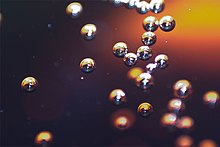This article needs additional citations for verification. (November 2021) |
Effervescence is the escape of gas from an aqueous solution and the foaming or fizzing that results from that release.[1] The word effervescence is derived from the Latin verb fervere (to boil), preceded by the adverb ex. It has the same linguistic root as the word fermentation.[citation needed]

Effervescence can also be observed when opening a bottle of champagne, beer or carbonated beverages such as some carbonated soft drinks. The visible bubbles are produced by the escape from solution of the dissolved gas (which itself is not visible while dissolved in the liquid).
Chemistry edit
Although CO2 is most common for beverages, nitrogen gas is sometimes deliberately added to certain beers. The smaller bubble size creates a smoother beer head. Due to the poor solubility of nitrogen in beer, kegs or widgets are used for this.[2]
In the laboratory, a common example of effervescence is seen if hydrochloric acid is added to a block of limestone. If a few pieces of marble or an antacid tablet are put in hydrochloric acid in a test tube fitted with a bung, effervescence of carbon dioxide can be witnessed.
This process is generally represented by the following reaction, where a pressurized dilute solution of carbonic acid in water releases gaseous carbon dioxide at decompression:
In simple terms, it is the result of the chemical reaction occurring in the liquid which produces a gaseous product.[3]
See also edit
- Cavitation
- Carbonation
- Effervescent tablet
- Precipitation (chemistry), the "down-arrow"
References edit
- ^ "Effervescence". Archived from the original on 2007-06-09. Retrieved 2010-04-14.
- ^ Baxter, E. Denise; Hughes, Paul S. (2001). Beer: Quality, Safety and Nutritional Aspects. Royal Society of Chemistry. p. 22. ISBN 9780854045884.
nitrogen gas beer
- ^ G. Liger-Belair et al., "Study of Effervescence in a Glass of Champagne: Frequencies of Bubble Formation, Growth Rates, and Velocities of Rising Bubbles", Am. J. Enol. Vitic. 50:3 (1999), 317–323.